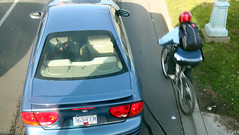A few women have suggested to me that I dress like a woman for increased passing distance. Dr. Walker tested this idea in his study by donning a wig while cycling. He found that wearing the wig resulted in an average of 14 centimetres (5.5 inches) more space when passing.
Dr. Walker's study has been accepted for publication in the journal Accident Analysis and Prevention. Read more here and here. See also Ian Walker's observations about the media, white vans and cyclist overtaking distance.
Blogosphere mentions: Helmet danger, "Do bike helmets...", and lycra clad street warrior.
Related:
- Bicycle Helmet Research Foundation.
- British Medical Journal on helmet laws.
- Survey of helmet laws in the United States.
Photo info: "Stupid Cyclist" squeezing car off road and slowing bus down by Professional Recreationalist.


The important question is not whether helmet use affects crash rates but how helmet use affects injury and death rates.
ReplyDeleteI have a strong suspicion that crash rates have a direct effect on the number of injuries and deaths...
ReplyDeleteI wonder if the helmet is the key or just the appearance. If I'm wearing "urban warrior " clothing, a messenger bag, dark sunglasses but no helmet will vehicles also pass closer to me?
ReplyDeleteI did a study of my own on passing distance too. My finding: The passing distance is directly proportional to the distance the bicyclist is away from the CURB.
ReplyDeletePaul pointed out the central idea this 'study' neglected, and that's lane positioning. According to the LCI list, there's a chart showing the author's greates distance from the curb was a little over a meter. Hugging the curb is a sure-fire way to have motorists pass far too closely.
ReplyDeleteI may have more on this later over on CycleDog, Fritz.
Ed, I was just tryin' to be FUNNY. The day I git serious, is the day the Tulsa Police Department Santa Task Force gives IN and goes HOME. That's when Captain Pecker rolls AGAIN.
ReplyDeleteHello,
ReplyDeleteThis was my research - I was alerted to this entry yesterday.
I was indeed only up to 1.25 metres from the kerb, but you have to realise that we have much smaller roads here in the UK and that 1.25m is practically in the centre of the lane on most roads. They tend to be something like 5.2m in total width in urban settings.
I totally agree with the poster who mentioned that distance from the kerb is important and I did study this factor, riding at 5 different distances from the edge of the road - the results were clear: the further out I rode, the closer drivers got. Interestingly, this was the opposite to what I expected and I was not really aware of it happening as I rode: it was only when I analysed the readings that I saw the results. You can see them at http://drianwalker.com/overtaking
Cheers,
Ian
AASHTO standard for roadway width is approximately 4 metres, 12 feet. My studies indicate the further a bicyclist is AWAY from the curb, the further away the passing motor vehicle.
ReplyDeleteIn fact, at a distance of 2 metres from the curb in the outide curb lane, the motor vehicle MUST pass in the adjacent inside lane.
Which leaves approximately 2.5 metres space between motor vehicle and bicyclists AND, more importantly, 2 metres space to curb, for emergency evasive manuvers, should the said motorist choose to be a real ASSHOLE, trying to run down the bicyclist. Of course, dancing with the cars requires the use of a rear view mirror.
With all due respect, your study is without merit.
In your study, your riders also used women's wigs. In the US, Halloween is upon us.
ReplyDeleteI might consider doing a study of bicyclists in various costumes: witch, Little Bo Peep, and perhaps Superman.
I have conducted a study in which the rider donned full battle dress uniform of the 82nd Airborne Light Bicycle Infantry, towing Captain Pecker. Unfortunately, the rider was arrested, charged with outraging public decency, and spend 62 days in the county JAIL. Needless, to say, all findings were INVALID.
Perhaps the pyschology of the Brits are not relevant to the US. Invalidate my last comment about your study having no merit. My apologies. I am being too States-centric.
I do remember a jolly chap in San Antonio, TX who insisted on the b-day suit costume. Through the grapevine, I heard the chap is no longer with us. Someone plugged him with a .357 magnum. Perhaps he was wearing some butt-ugly socks.
ReplyDeleteYour field of study, traffic psychology, is interesting. There is much psychology at play when in traffic. In the US, it's more like psychology warfare.
ReplyDeleteFor example, US motorists consider people use bicycles as their primary means of transport lowlifes, drunks, and n'er-to-do. It is useful to use those stereotypes to some advantage for the bicyclists.
Some of my studies include the crazy bicyclist weaving all over the road like a drunk or a psychotic schizophrenic. In the US, it works wonders. Motorists pass with considerable care and great distance.
Of course, installing a sign minicking the MUTCD stop sign on the back of the bicycle with the words, SLOW COP AHEAD, works great too.
My studies have indicated some motorist consideration for the bicyclist towing a baby trailer. Even without a baby inside, motorists seem to pass with increased care and distance.
Of course, to generate some measure of heat, one could install a sign, BACK OFF DIPSHIT, which generates either laughter or extreme road rage.
But, to keep it all simple, just flip the bird.